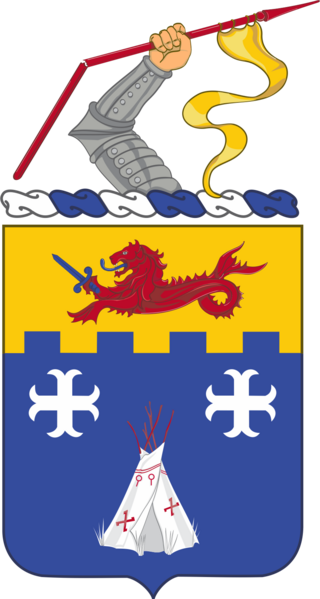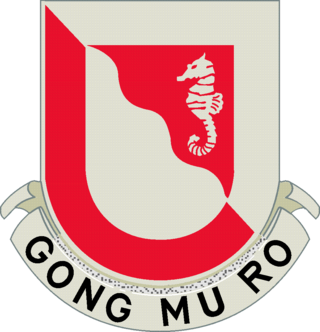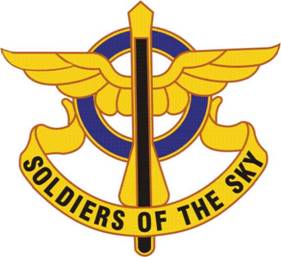
The U.S. Military Assistance Command, Vietnam (MACV) was a joint-service command of the United States Department of Defense, composed of forces from the United States Army, United States Navy, and United States Air Force, as well as their respective special operations forces.

The 12th Infantry Regiment is a unit of the United States Army. The 12th Infantry has fought in seven wars from the Civil War to the Global War on Terrorism and has been awarded 19 Presidential Unit Citations, five Valorous Unit Awards, a Joint Meritorious Unit Award, two citations in the Order of the Day of the Belgian Army, Nine Republic of Vietnam Crosses of Gallantry, the Republic of Vietnam Civil Action Honor Medal Third Class, a Meritorious Unit Commendation, and the Belgian Fourragere.

II Field Force, Vietnam was a United States Army Corps-level command during the Vietnam War.

The United States Army, Vietnam (USARV) was a Corps-level support command of the United States Army during the Vietnam War.

The 1st Battalion, 227th Aviation Regiment is an attack helicopter battalion of the Combat Aviation Brigade, 1st Cavalry Division. The battalion is an AH-64 Apache battalion based at Fort Cavazos, Texas.

This article incorporates public domain material from websites or documents of the United States Army.

The 64th Brigade Support Battalion, nicknamed "Mountaineers," is a United States Army support battalion, assigned to the 3rd Armored Brigade Combat Team, 4th Infantry Division in Fort Carson, Colorado.

The 864th Engineer Battalion is a combat engineer battalion of the United States Army based at Joint Base Lewis-McChord, Washington. The battalion is a subordinate unit of 555th Engineer Brigade.

The 1st Signal Brigade is a military communications brigade of the United States Army subordinate to the Eighth United States Army and 311th Signal Command in Hawaii, and located at Camp Humphreys in South Korea.

The 3rd Battalion, 319th Field Artillery Regiment is the field artillery battalion that directly supports the 1st Brigade Combat Team, 82nd Airborne Division. Known as the "Gun Devils", 3–319th AFAR has participated in battles from World War I to the current day, and is one of the most highly decorated field artillery units in the United States Army. The battalion's mission is "3-319th AFAR stands ready to deploy worldwide within 18 hours of notification, execute a parachute assault and conduct full-spectrum operations. Specifically, the battalion will provide responsive lethal and nonlethal fires in support of forcible entry and airfield seizure, and integrate and synchronize the effects of fires to achieve the 1BCT commander's intent."

The 14th Brigade Engineer Battalion is a Combat Engineer Battalion of the United States Army based at Joint Base Lewis-McChord, Washington. The battalion is a subordinate unit of the 2nd Stryker Brigade, 2nd Infantry Division, and I Corps. The battalion's official motto is "Gong Mu Ro" and battle cry "Rugged!".

The 362nd Signal Company is a military communications company of the United States Army subordinate to the 41st Signal Battalion, 1st Signal Brigade and located at Seoul Air Base in South Korea.

The 10th Aviation Regiment is an aviation regiment of the U.S. Army.
The 64th Transportation Company was constituted 1 May 1936 in the Regular Army as Company A, 1st Battalion, 29th Quartermaster Regiment. It was activated 1 June 1941 at Fort Leonard Wood, Missouri.

Long Binh Post is a former U.S. Army base located in Long Bình, Đồng Nai between Biên Hòa and Saigon, Vietnam. The base functioned as a U.S. Army base, logistics center, and major command headquarters for United States Army Vietnam (USARV). Long Binh Post was also unofficially known as "Long Binh Junction, influenced by the widely used initials of then-President Lyndon B. Johnson.

The 326th Medical Battalion was a divisional support medical unit of the United States Army. It supported the 101st Airborne Division, located at Fort Campbell, Kentucky. Its lineage and honors are perpetuated by the 626th Support Battalion, 101st Airborne Division, Fort Campbell, Kentucky.

The 101st Airborne Division Artillery (DIVARTY) is the force fires headquarters for the 101st Airborne Division at Fort Campbell, Kentucky. The DIVARTY has served with the division in World War II, Vietnam, Operations Desert Shield and Storm, Operation Iraqi Freedom, and in peacetime at Camp Breckinridge and Fort Campbell, Kentucky, and Fort Jackson, South Carolina. The DIVARTY was inactivated in 2005 as part of transformation to modular brigade combat teams, but was reactivated on 16 October 2014 to provide fire support coordination and mission command for the training and readiness of field artillery units across the division.

The 2nd Battalion, 320th Field Artillery Regiment is an inactive field artillery battalion of the United States Army. The battalion has been assigned to the 82nd Airborne Division, 11th Airborne Division and 101st Airborne Division. The battalion has participated in World War I, World War II, Vietnam, Operation Desert Storm, Operation Iraqi Freedom, and Operation Enduring Freedom. The battalion deactivated in July 2015 as part of ongoing force reductions, and its personnel and equipment were reflagged as the 2nd Battalion, 32nd Field Artillery Regiment.

The United States Army Medical Command, Vietnam (USAMEDCOMV) provided Echelon/Role 3 Health Service Support to units of the United States Army, Vietnam (USAV). It was a Table of Distribution and Allowances organization created by consolidating the staffs of the 44th Medical Brigade and the USAV Surgeon's Office. This action was taken as part of the overall drawdown of forces in Vietnam in an effort to reduce headquarters staffs and increase efficiencies. As the medical footprint further reduced in 1972, it was replaced by the United States Army Health Services Group, Vietnam on 30 April 1972.





























